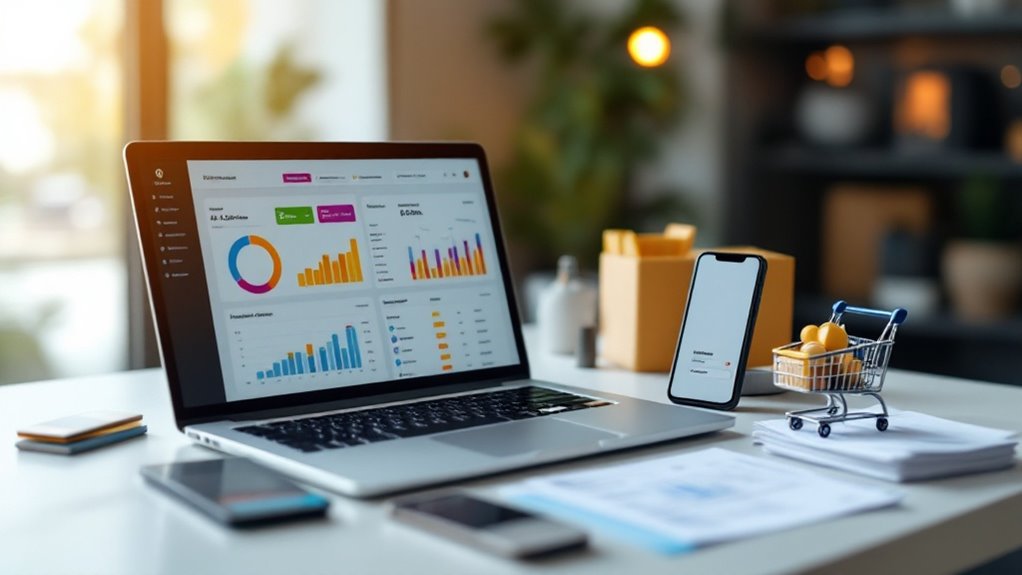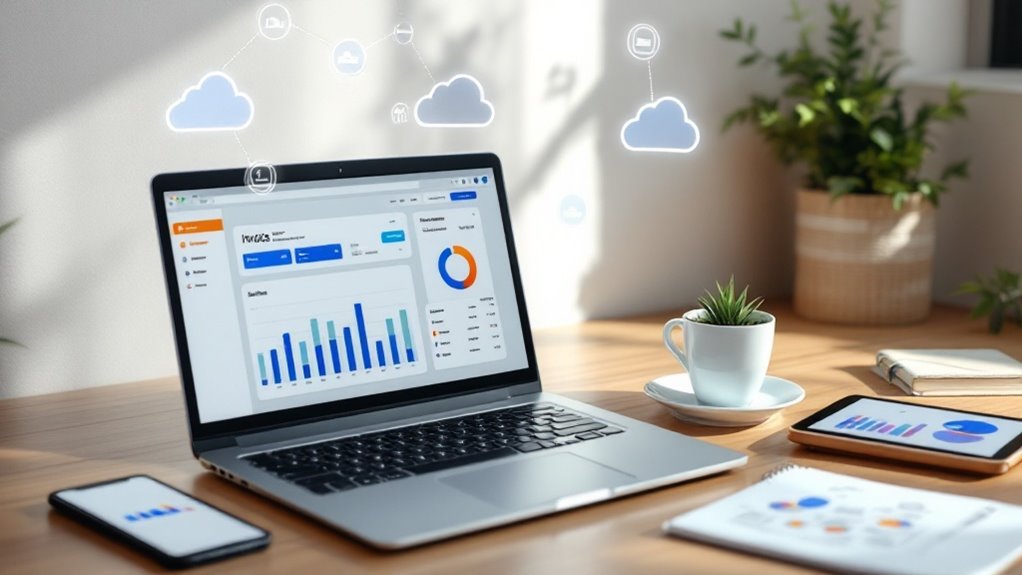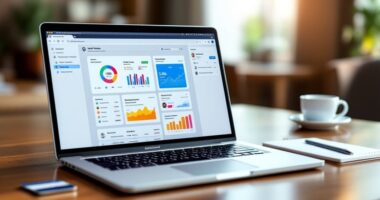Small business purchasing software streamlines procurement processes through automated workflows, supplier management, and spend tracking. Modern cloud-based solutions like Tradogram and Precoro offer essential features including purchase order automation, approval routing, and real-time budget monitoring. These tools reduce manual workload while providing valuable spending insights. Popular options balance functionality with affordability, helping small businesses control costs and maintain vendor relationships. Understanding key features and selection criteria guarantees the best fit for growing operations.
Quick Overview
- Tradogram and Procurify offer budget-friendly cloud solutions specifically designed for small businesses with essential spend tracking features.
- Automated purchase order processing and approval workflows reduce manual errors while speeding up purchasing procedures for smaller teams.
- Cloud-based platforms enable mobile access and team collaboration, perfect for small businesses with remote or flexible work arrangements.
- Small businesses benefit from real-time budget tracking and spend analysis dashboards to maintain tight financial control.
- Integration capabilities with existing systems ensure smooth data flow without requiring extensive IT resources or technical expertise.
Why Small Businesses Need Purchasing Software in 2025

Small businesses’ evolving needs in 2025 make purchasing software an essential investment rather than a luxury. In today’s technology-driven market, businesses must streamline their procurement processes to remain competitive and efficient. Implementing procurement software helps companies significantly cut purchasing costs through optimized supplier negotiations and comprehensive price comparisons.
This software offers critical advantages for small businesses:
- Automated task management reduces manual workload
- Real-time visibility into spending patterns improves budget control
- Centralized supplier information enhances negotiation power
- Scalable features grow with business needs
- Integration capabilities guarantee seamless data flow
The technology particularly benefits small businesses by:
- Minimizing costly procurement errors
- Reducing administrative overhead
- Improving supplier relationships
- Enabling faster decision-making
- Supporting distributed work environments
With 75% of businesses increasing their software investments, small companies must adapt to stay competitive in an increasingly digital marketplace.
Essential Features That Drive Procurement Success
Success in modern procurement hinges on selecting software with the right combination of essential features. Small businesses need tools that streamline operations while providing robust control over purchasing processes. Today’s procurement solutions offer powerful capabilities that transform how companies manage their purchasing workflows. Implementing no-code customization allows businesses to adapt the software to their specific needs without requiring technical expertise.
Key features driving procurement success include:
Strategic procurement success depends on essential features that streamline operations, automate processes, and provide actionable insights.
- Automated purchase order processing and multi-level approval workflows that reduce errors and speed up transactions
- Extensive supplier management tools for tracking performance and maintaining strong vendor relationships
- Real-time budget tracking and spend analysis dashboards for better financial control
- Cloud-based platforms with mobile accessibility for seamless collaboration across teams
- Advanced reporting and analytics that provide actionable insights for strategic decision-making
These core features help small businesses optimize their procurement processes, control costs, and maintain competitive advantages in today’s market.
Top Software Solutions and Their Unique Advantages

Leading the market in procurement solutions, several software platforms offer distinct advantages for small businesses seeking to modernize their purchasing processes. Each solution targets specific business needs while maintaining efficiency and cost-effectiveness.
For budget-conscious companies, Tradogram and Procurify deliver affordable cloud-based options with essential features like spend tracking and approval workflows. Precoro excels in automation, eliminating manual tasks through three-way invoice matching and streamlined processes. These platforms employ formal language to maintain professional standards in their documentation and user interfaces. Kissflow’s no-code platform stands out with its user-friendly interface and customizable workflows, making it ideal for businesses prioritizing ease of use.
Meanwhile, SAP Ariba provides thorough procurement tools for companies planning significant growth, offering advanced supplier management and risk assessment capabilities. These solutions balance functionality with scalability, ensuring small businesses can choose a platform that matches their current needs and future aspirations.
Making the Right Choice: Selection Criteria Explained
Selecting the right procurement software requires careful evaluation of multiple criteria to guarantee a worthwhile investment. When reviewing potential solutions, businesses must consider both immediate needs and future growth requirements to make an informed decision that delivers long-term value.
Smart procurement software selection balances current operational needs with future scalability to ensure lasting business value.
The following criteria are crucial in the evaluation process:
- Clear alignment with business objectives, including essential features for procurement, reporting, and inventory management
- Scalability options through cloud-based solutions and modular designs that grow with the company
- Integration capabilities with existing systems through APIs and pre-built connectors
- Transparent pricing structure with a detailed understanding of total ownership costs
- User-friendly interface combined with reliable customer support and training resources
The selection process should focus on finding software that not only meets current operational demands but also provides flexibility for future adaptations and expansions. Taking time to thoroughly evaluate options helps businesses avoid impulsive decisions that could lead to unnecessary challenges and disappointments down the road.
Future-Proofing Your Purchase Management System

Modern businesses must strategically future-proof their purchase management systems to stay competitive in an evolving digital landscape. To achieve this, companies should focus on implementing scalable technology solutions and maintaining robust data management practices. With anticipated supply chain disruptions affecting businesses, having adaptable systems is more critical than ever.
| Strategy | Benefit | Implementation |
|---|---|---|
| Cloud Solutions | Flexible Growth | Start with basic features, expand as needed |
| Data Integration | Better Insights | Connect with existing systems gradually |
| Automation Tools | Reduced Errors | Begin with core processes first |
Key elements of a future-ready system include investing in cloud-based software that grows with the business, incorporating AI capabilities for smarter decision-making, and establishing strong supplier networks. Regular system updates, staff training, and continuous process improvements guarantee the purchase management system remains effective and adaptable to changing market conditions.
Frequently Asked Questions
How Long Does It Typically Take to Train Staff on New Purchasing Software?
Training staff on new purchasing software typically takes 1-5 days for thorough onboarding, though duration varies based on software complexity and staff expertise.
Web-based training modules can be completed in several hours, while intensive in-person courses may extend to a full work week. Key factors affecting training time include software complexity, staff’s technical proficiency, and availability of learning resources. Most organizations achieve basic operational competency within 2-3 days of focused training.
Can Purchasing Software Handle Multiple Currencies and International Transactions Automatically?
Modern purchasing software effectively handles multiple currencies and international transactions automatically. The systems provide real-time currency conversion, generate multi-currency purchase orders, and process international payments seamlessly. They automate tax calculations, duty handling, and compliance requirements for cross-border transactions.
These platforms integrate with accounting software to maintain accurate financial records. Additionally, they typically include features for tracking international shipments and managing global supplier relationships.
What Happens to Stored Data if We Decide to Switch Software Providers?
When switching software providers, businesses typically retain the right to export their stored data, though the process varies by provider. Most vendors offer data export options in common formats like CSV or JSON, sometimes with additional fees.
It’s essential to review data ownership policies and establish a departure plan before switching. Companies should maintain independent backups and verify the new provider’s import capabilities to guarantee a seamless shift and prevent data loss.
Are There Industry-Specific Purchasing Software Solutions for Retail or Manufacturing Businesses?
Like a well-tailored suit, industry-specific purchasing software fits the unique needs of different business sectors.
For retail businesses, solutions focus heavily on inventory management, supplier relationships, and omnichannel sales tracking. Manufacturing-oriented software emphasizes raw materials procurement, production scheduling, and supply chain optimization.
Companies like Oracle Cloud for Retail and Tipalti offer specialized features tailored to each industry’s requirements, helping businesses streamline their purchasing processes and maximize efficiency.
How Often Should Small Businesses Upgrade Their Purchasing Software Systems?
Small businesses should update their purchasing software based on a strategic schedule. Minor updates and security patches should be implemented every 3-6 months, while major system upgrades should be evaluated every 2-3 years.
Key triggers for upgrades include:
- Vendor support changes
- Security vulnerabilities
- Performance issues
- New business requirements
- Industry compliance updates
Regular maintenance guarantees the best possible system performance, thereby preventing costly emergency upgrades and potential security risks.
Conclusion
Like a compass guiding ships through stormy seas, purchasing software steers small businesses toward operational excellence in 2025 and beyond. By carefully selecting a solution that aligns with business needs, integrates essential features, and adapts to future challenges, companies can transform their procurement processes from a paper maze into a streamlined digital journey. The right software isn’t just a tool—it’s the key to unsealing sustainable growth and competitive advantage.








